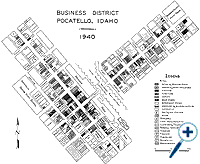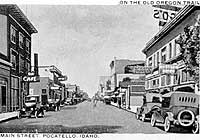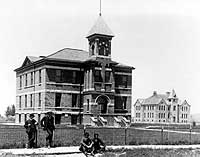
|
Page118
|
 |
| Map of downtown Pocatello, 1940, from Wrigley (1942). |
Naming
the Streets of Downtown
The matter of naming
the streets tells us something of the political character of the early town.
At the outset, streets paralleling the railroad were named for presidents, beginning
with the current president, Harrison, next to the right-of-way, and moving westerly
by earlier presidents in a reverse order, that is, Cleveland, Arthur, Garfield
and so forth. The equivalent streets east of the railroad were given number
designations, viz. 1st, 2nd, 3rd, etc. East-west cross streets on both sides
of the tracks were given letter designations, A, B, C, etc.
By 1906, the growing municipality felt the need to require the numbering of buildings to facilitate "free" mail delivery and to give some streets more appropriate names. The east-west street designations were changed from letters to the names of early explorers, trappers, generals, railroad officials and the like, which names they still bear. One American president was slighted in the naming of Pocatello's streets. As already noted, the street next to Harrison was Cleveland. In 1906, a Republican city council responded to a petition signed by every merchant along Cleveland Avenue by changing its name to Main Street. Not only that, but in later years a plat annexed to the north side of town bore the names of the presidents following Harrison, and although the next president in time was Cleveland, the new plat picked up the president names with McKinley, so that the man who was president twice does not have a street named after him in Pocatello.
Dusty
Streets and a City Divided
The problems faced
by the young town were those of all frontier communities. The fine loess soil
produced clouds of dust when wagons rolled over dry streets. The streets were
not paved so it was necessary to water the streets to keep the dust down. However
the city water supply was privately controlled and little water was made available
for this purpose. Sidewalks were slow in coming.
 |
 |
|
(left) Early 1920s postcard of Main Street, Pocatello, looking north near the intersection with Lewis. On the left is the Benson Hotel. On the right is the present Station Square, then the Fargo-Wilson-Wells Department Store, which housed the bus depot and the Western Union office. Bannock County Historical Society Collection. (right) View looking north from East Center Street at the Bannock County Courthouse in foreground and Bonneville School in background, about 1903. Note the lack of trees. The Courthouse was built in 1902, added onto in 1913 and razed in 1955. It occupied what is now the parking lot of the new courthouse, which was built in front of it. The school (on the present site of the U.S. Post Office) was built in 1895 and razed in the early 1960s. The Bear Lake County Courthouse (still standing in Paris) has the same architectural design as the old Bannock County Courthouse. Bannock County Historical Society Collection. |
|